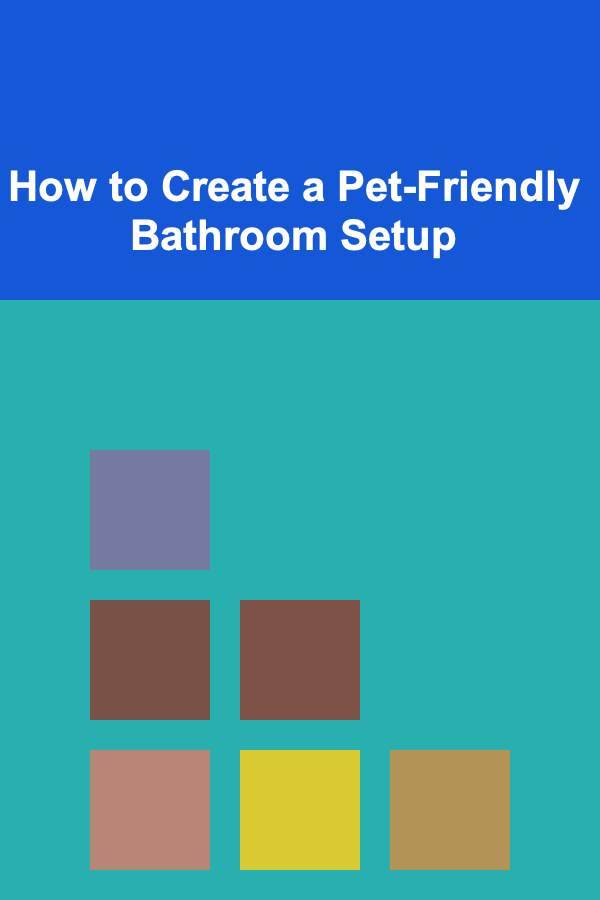
How to Stage Your Home for a Successful Open House Event
ebook include PDF & Audio bundle (Micro Guide)
$12.99$10.99
Limited Time Offer! Order within the next:

Staging your home for an open house is one of the most powerful tools in selling your property. An open house is an opportunity for prospective buyers to view the property without the pressure of a private showing. It is an event where they can freely imagine themselves living in the space, which is why home staging plays a crucial role in making your home feel inviting, desirable, and memorable.
Staging goes beyond just cleaning and tidying up; it's about creating an emotional connection between the buyers and the space. When done correctly, staging can help your property stand out in a competitive market and lead to faster sales at higher prices.
In this article, we will explore how to stage your home effectively for a successful open house event, covering the essential elements of staging, helpful tips, and common mistakes to avoid.
Why Home Staging Is Important for an Open House
Before diving into the specifics of staging, it's essential to understand why home staging is so important for an open house. When prospective buyers walk into a property, they are not just evaluating the number of bedrooms or the size of the kitchen---they are imagining their lives in the space. They are thinking about where they will put their furniture, how they will use the rooms, and whether it feels like home. The goal of staging is to help buyers visualize the potential of a home and fall in love with it.
Here are a few key reasons why staging is vital for an open house:
1. First Impressions Matter
An open house provides the first chance for buyers to experience your home in person. The way your home looks and feels when they walk through the door can significantly impact their interest. Staging ensures that the space is presented in the best possible light, making it easier for potential buyers to connect with the property.
2. Creating Emotional Appeal
Homes that are staged are often more inviting and emotionally appealing. By highlighting the strengths of the space and minimizing any distractions, staging allows buyers to imagine themselves living in the home, creating an emotional attachment that is crucial to the sales process.
3. Standing Out in a Competitive Market
In a competitive real estate market, staging can give your home an edge. A well-staged home often photographs better, which is important for online listings. Staged homes also tend to get more attention during open houses because they look polished and move-in ready.
4. Helping Buyers Visualize the Space
A key challenge for many buyers is visualizing how their furniture and belongings will fit in a new space. Staging helps eliminate this uncertainty by demonstrating the functional potential of each room. By arranging furniture in a thoughtful, functional way, you help buyers see the possibilities.
5. Potential for a Faster Sale
Staged homes typically sell faster than non-staged homes. According to a study by the National Association of Realtors (NAR), homes that are staged sell 73% faster than those that are not. The quicker your home sells, the less time it will spend sitting on the market, which is especially important in a fluctuating or competitive market.
How to Stage Your Home for a Successful Open House Event
Now that we understand why staging is important, let's take a look at how to stage your home effectively for an open house. There are several key areas to focus on, each contributing to the overall appeal of the property.
1. Start with a Deep Clean
Before you can begin staging, it's essential to start with a thorough cleaning of your home. A clean home is inviting and will immediately create a positive impression. This process should go beyond just surface cleaning. Pay attention to the following areas:
- Windows and Mirrors: Clean all windows and mirrors to allow natural light to flow into the space. Streak-free windows will make the home feel brighter and more open.
- Floors and Carpets: Sweep, mop, or vacuum all floors. If you have carpets, consider having them professionally cleaned. Clean floors make the space feel fresh and well-maintained.
- Kitchen and Bathrooms: Clean appliances, counters, and backsplashes in the kitchen. In the bathroom, scrub sinks, tubs, and toilets, and replace worn-out towels with fresh, neutral-colored ones.
- Odors: Make sure there are no unpleasant odors in the home. Avoid strong scents like heavy air fresheners, as they can be off-putting. Instead, keep the space smelling fresh by opening windows, using natural air purifiers, or lightly scented candles.
A spotless home will immediately convey that it has been well cared for and is ready for new owners.
2. Declutter Every Room
Clutter is one of the biggest turn-offs for potential buyers. It can make spaces feel smaller, less inviting, and chaotic. One of the most important aspects of staging is decluttering. Here's how to tackle this task:
- Remove Personal Items: Personal items like family photos, trophies, and collections can distract buyers from imagining their own lives in the space. Remove personal mementos and replace them with neutral, non-personal decor items.
- Clear Countertops: In the kitchen and bathroom, clear off countertops and remove any small appliances, toiletries, or unnecessary items. A clean, clear countertop gives the space a more open and spacious feel.
- Minimize Furniture: Less is more when it comes to furniture. Overcrowded rooms can feel cramped and unappealing. Remove any excess furniture and focus on pieces that highlight the room's best features and function.
- Organize Closets and Storage: Buyers will want to check out your closets and storage spaces, so make sure they are organized and clutter-free. A neat closet not only looks more appealing but also shows the storage potential of the home.
3. Create a Neutral Palette
Neutral colors are your best friend when it comes to staging. While you may love bold, bright colors, they can be polarizing and may not appeal to all buyers. A neutral color scheme, on the other hand, is universally appealing and allows potential buyers to imagine how they would personalize the space.
- Walls: If the walls are painted in bold or dark colors, consider repainting them in neutral tones such as beige, gray, or off-white. These colors make spaces feel larger and lighter, and they provide a blank canvas for buyers.
- Furniture and Accessories: Opt for neutral furniture pieces that complement the walls. You can add pops of color through throw pillows, rugs, and artwork, but keep the overall aesthetic calm and cohesive.
Neutral tones create a backdrop that allows buyers to focus on the space itself, rather than the decor.
4. Maximize the Home's Best Features
Every home has its strengths, and staging is all about highlighting those features. Whether it's a beautiful fireplace, large windows, or spacious living areas, ensure that these aspects are showcased to their fullest potential.
- Arrange Furniture to Highlight Focal Points: Position furniture in a way that draws attention to key features. For example, if you have a fireplace, arrange seating to face it. If you have a large window with a great view, arrange furniture to take advantage of the view.
- Add Lighting: Proper lighting can make all the difference in how a space feels. Open curtains and blinds to allow natural light to flood the space. Add floor lamps, table lamps, and overhead lights to brighten rooms that may be too dark. Well-lit rooms feel warmer and more inviting.
5. Depersonalize and Neutralize the Decor
While you may be proud of your personal style, it's essential to create a neutral and depersonalized environment for an open house. Buyers need to be able to envision themselves in the space, and personal items and specific tastes can interfere with that process.
- Remove Personal Photos and Items: As mentioned earlier, take down personal photographs, family portraits, and any items that have sentimental value. Replace these with generic artwork, framed prints, or simple decor items that help create a clean and neutral atmosphere.
- Neutral Decor: Replace bold, quirky decor with more neutral choices. For example, swap out vibrant, patterned rugs with subtle ones that complement the rest of the space. Keep accessories like vases, sculptures, and candles simple and elegant.
6. Stage Outdoor Spaces
Don't forget about the exterior and outdoor spaces. The outdoor area is often the first thing people see when they arrive, and it can create a lasting first impression.
- Clean Up the Yard: Mow the lawn, trim the hedges, and weed the garden. A well-maintained lawn instantly adds curb appeal and makes the home feel well cared for.
- Stage the Patio or Deck: If your home has a patio or deck, stage it with comfortable outdoor furniture, pillows, and potted plants. This helps buyers envision themselves entertaining or relaxing outdoors.
- Add Curb Appeal: Simple touches like a new doormat, freshly painted front door, or potted plants by the entryway can boost curb appeal and create a welcoming entrance.
7. Hire a Professional Stager (Optional)
If you're feeling overwhelmed by the task or don't know where to start, consider hiring a professional stager. A staging expert has experience in transforming spaces and knows how to highlight your home's best features while minimizing any flaws. They can help you with furniture placement, decor choices, and overall layout. While hiring a professional stager comes with a cost, it may be worth the investment for a quicker sale at a higher price.
8. Final Touches Before the Open House
As the open house approaches, take a step back and look at your home through the eyes of a potential buyer. Walk through each room and make sure it feels inviting, spacious, and well-maintained.
- Set the Mood with Music: Playing soft background music can create a calm, welcoming atmosphere. Keep the music low and unobtrusive.
- Smell and Sensory Appeal: Consider placing fresh flowers, baking cookies, or using an essential oil diffuser to create a pleasant scent in the home.
- Ensure Everything Is Ready: Make sure all light bulbs are working, doors are open, and the home is ready to shine when buyers arrive.
Conclusion
Staging your home for a successful open house is an essential step in selling your property. It involves cleaning, decluttering, neutralizing decor, highlighting the best features, and creating an inviting atmosphere that helps buyers visualize themselves living in the space. By taking the time to stage your home thoughtfully, you can make a lasting impression, increase the perceived value of the property, and potentially sell your home faster and at a higher price.
Reading More From Our Other Websites
- [Personal Investment 101] Investing in Deep Learning Projects to Generate Long-Term Passive Income
- [Personal Financial Planning 101] How to Understand and Manage Your Credit Card Debt
- [Home Storage Solution 101] How to Choose the Right Storage Bins for Every Room
- [Survival Kit 101] Essential Survival Tools for a Bug Out Bag: Must-Have Gear for Emergency Evacuations
- [Personal Financial Planning 101] How to Manage Your Finances as a Freelancer or Entrepreneur
- [Home Budget Decorating 101] How to Repurpose Old Furniture for Stylish New Pieces
- [Personal Investment 101] How to Choose the Best Investment Strategy for Your Risk Profile
- [Home Rental Property 101] How to Draft Water-Tight Rentals with Flexible Lease Terms Agreements
- [Biking 101] Top 5 Bike Pedals for Comfort and Performance
- [Star Gazing Tip 101] Night Sky Meditations: Transformative Lessons from the Stars for Modern Living

Do-It-Yourself Repairs: Simple Fixes to Save Money and Boost Your Skills
Read More
How to Create a Pet-Friendly Bathroom Setup
Read More
How to Integrate Dropshipping Suppliers with Your Ecommerce Platform
Read More
How to Start a Profitable Website Design Side Business from Home
Read More
Strategic Operations Coordination: Enhancing Efficiency and Effectiveness as an Operations Coordinator
Read More
Mastering Influencer Marketing for Print-on-Demand (POD)
Read MoreOther Products

Do-It-Yourself Repairs: Simple Fixes to Save Money and Boost Your Skills
Read More
How to Create a Pet-Friendly Bathroom Setup
Read More
How to Integrate Dropshipping Suppliers with Your Ecommerce Platform
Read More
How to Start a Profitable Website Design Side Business from Home
Read More
Strategic Operations Coordination: Enhancing Efficiency and Effectiveness as an Operations Coordinator
Read More